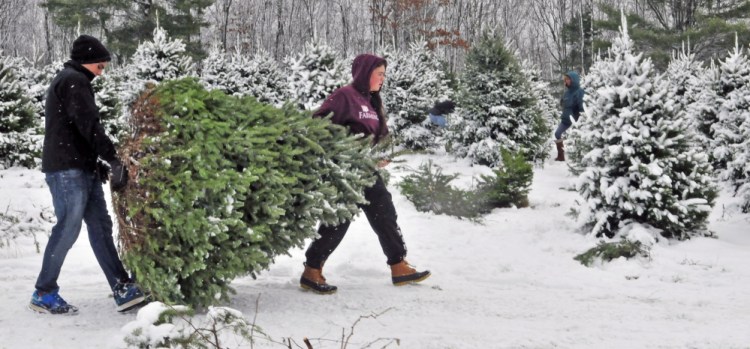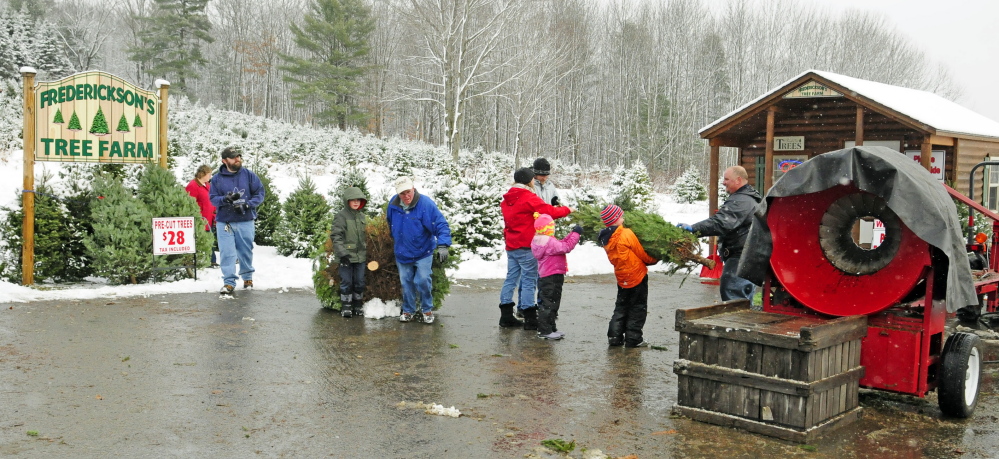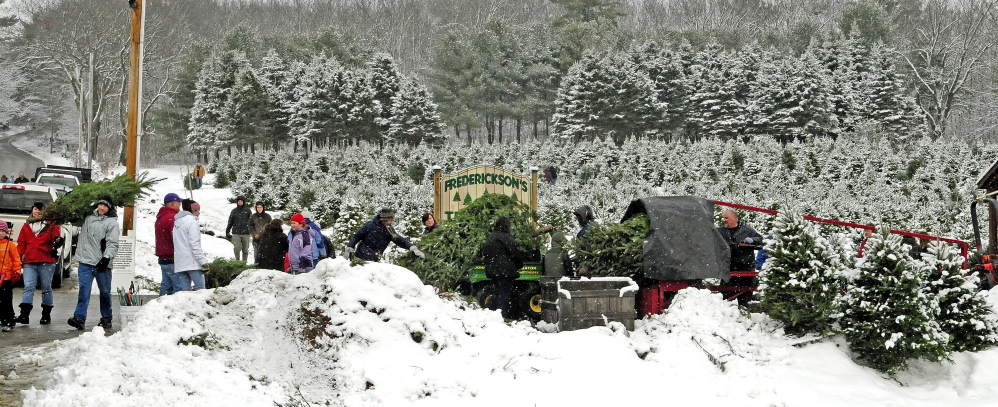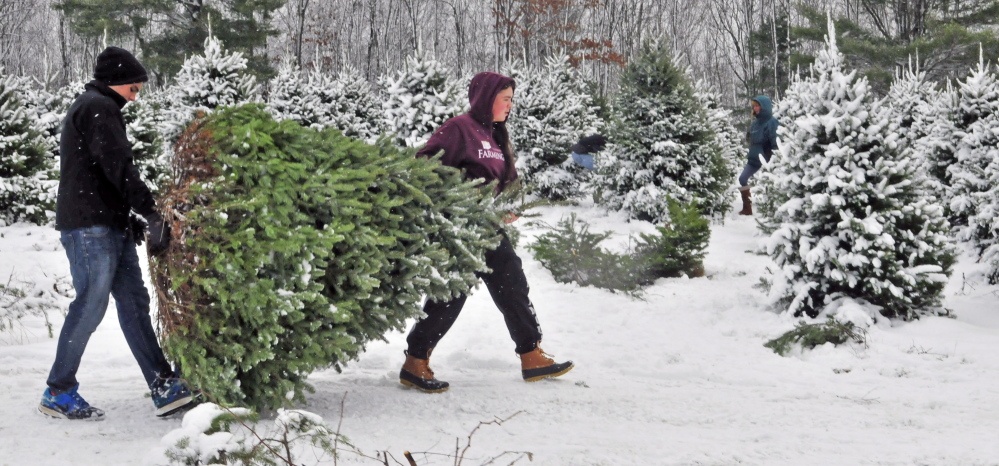Christmas tree farmers in central Maine offering pick-your-own and cut-your-own trees were expecting a big weekend this past Saturday and Sunday thanks to a messy weekend before.
People usually start buying Christmas trees right after Thanksgiving, central Maine tree farmers said, but the busiest weekends are the first two in December. After that, sales taper off for the rest of the month, farmers said.
With a storm dropping a wintry mix of ice and snow the previous Saturday, some Christmas tree farmers reported a slower weekend then usual for the beginning of December.
“I think this weekend’s going to be extremely busy with the nice weather,” Mark Andre, owner of Thornridge Farms Nursery in Fairfield, said Thursday. “I think people are a little bit late getting their trees this year.”
After the messy weather two Saturdays ago on Dec. 6, the next Sunday was big for Frederickson’s Tree Farm, said owner Tom Auger.
Typically, the Monmouth Christmas tree farm sells around 1,400 trees each year. On Dec. 7, it sold 440 trees, about a third of its yearly business, Auger said.
“It was nuts. It was crazy,” he said.
Ken Curtis, owner of Curtis Tree Farm in Pittston, said last week he was looking forward to this past weekend because of the weather forecast, but even with poor weather, loyal customers will eventually get their trees.
“When my customers want their Christmas trees, they pretty much come regardless of what the weather’s like. If it looks like the following day’s going to be pretty good, they’ll put it off a day,” Curtis said. “We’ve sold trees in rain, snow and mixture of everything. It’s quite a sight to see, actually.”
Rainfall last week caused problems for Walter Gooley, owner of Gooley’s Christmas Tree Farm in Farmington. He said last week he couldn’t even get into one of his fields because it was so slick and muddy.
“You just deal with the weather as it come. You do the best you can,” he said.
But the frequent rain this spring and summer made for a good growing season, especially for balsam firs, said Gooley, a director for the Maine Tree Farm Association.
“All the growers in Maine had a real good year, growth-wise,” he said. “The trees that I’ve seen are really dark green and look very good. This year was a good year.”
Gooley, who worked for the Maine Forest Service for 34 years before opening his own Christmas tree farm, said many Christmas tree farmers do the operations as a way to supplement another business or to supplement income in retirement as in Gooley’s case. For farmers, they’re passionate about growing trees, he said, just like their customers are passionate about cutting them down.
“Everybody who comes to get a Christmas tree, 99 percent of them are happy. And all the kids are all juiced up, and they’re happy, happy, happy,” Gooley said. “They can hardly wait for Christmas. The Christmas tree means a lot to the younger generation.”
The number of Christmas trees harvested across the country has dropped in the past decade, according to data from the U.S. Department of Agriculture’s Census of Agriculture compiled by the National Christmas Tree Association. About 20.8 million Christmas trees were harvested in 2002, and that dropped to 17.4 million in 2007 and 17.3 million in 2012, the latest year of the census.
But in Maine, Christmas tree farmers saw a dramatic bump between 2007 and 2012 when the statewide total increased more than 50 percent from 127,000 to 196,000, making Maine the ninth biggest Christmas tree-producing state.
Not all of those trees are pick-your-own or cut-your-own, however.
According to an annual consumer survey commissioned by the National Christmas Tree Association, about 85 percent of Christmas trees purchased are precut nationally. The results aren’t broken down by state.
In Maine, Christmas tree farms in northern Maine are more likely to sell to wholesale markets, said David Rochester, the Christmas tree specialist for the Maine Forest Service and one of the state’s ten district foresters.
The number of trees harvested can very depending on the weather, pests and diseases, Rochester said. For instance, needle cast disease in the south could benefit tree farmers in Maine, he said.
“If you get failed crops in other areas, that brings up the demand, and that’s a good thing for these guys, especially wholesalers,” Rochester said.
Rochester, who operates a Christmas tree farm his father opened in Eagle Lake, said it’s difficult to predict future sales because much of it is consumer driven. And despite the recent increase in the number of trees harvested, the total number of Christmas tree farms in Maine has declined compared with the 1980s and 1990s, Rochester said.
Seaman’s Tree Farm in Litchfield closed early this year because they didn’t have many trees left, and Curtis, the owner of the tree farm in Pittston, said this may be his last year.
“Once you get in your 70s, you begin to slow down a little,” Curtis said.
He said his farm had 20,000 trees at its peak, but he hasn’t planted any for several years in anticipation of shutting down. However, Curtis might keep going because he said he has an ample number of trees left.
“People keep reminding me for the last five years, I’ve been saying this is my last year, so I don’t know. Maybe I’ll be around another year,” Curtis said. “We’ll see. I just go year from year.”
Paul Koenig — 621-5663
Twitter: @paul_koenig
Send questions/comments to the editors.






Success. Please wait for the page to reload. If the page does not reload within 5 seconds, please refresh the page.
Enter your email and password to access comments.
Hi, to comment on stories you must . This profile is in addition to your subscription and website login.
Already have a commenting profile? .
Invalid username/password.
Please check your email to confirm and complete your registration.
Only subscribers are eligible to post comments. Please subscribe or login first for digital access. Here’s why.
Use the form below to reset your password. When you've submitted your account email, we will send an email with a reset code.